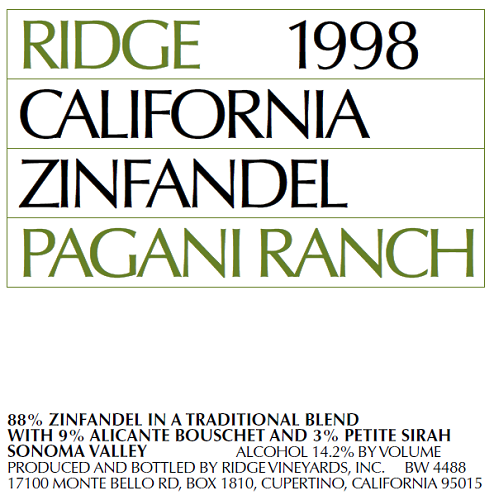
1998 Pagani Ranch Zinfandel
Wine Information
88% Zinfandel, 9% Alicante Bouschet, 3% Petite Sirah
Vintage
1998
Vineyard
Pagani Ranch
Appellation
Sonoma Valley
Alcohol By Volume
14.2%
Vintage Notes
If the crop on these nineteenth-century vines had not been short, the fruit might never have ripened—spring was that late. The mataro—which has made up approximately twelve percent of the wine each year since 1992—did not develop sufficiently to be included. The alicante, however, did; we increased the usual two or three percent to a record nine. Fermented on its own yeast, and aged in one- and two-year-old air-dried american oak, this lovely zinfandel exemplifies the rich claret style, in contrast to the late-picked style of several previous vintages. The combination of exotic spice, intense old-vine fruit, and firm acidity has produced a complex, elegant wine. It will be at its best over the next four to five years.
History
Since 1991, Ridge has made zinfandel from the old Pagani vineyard on the east-facing side of Sonoma Valley. The oldest vines were planted more than one hundred years ago, the youngest about eighty. The vineyard is mostly zinfandel, with some interplanted petite sirah, and several small blocks of alicante. Pagani Ranch is a fine example of what we look for in a zinfandel vineyard: low-yielding old vines, carefully tended by a quality conscious family who, in this case, have worked the land for four generations. The fact that this vineyard has survived so long is proof of its merit. An average site would have been abandoned during the thirteen years of Prohibition, or during the Depression. Louis Pagani, who passed away last winter at age 97, cared for these vines as if they were his children. Their quality is an impressive legacy. Pagani is situated in a cool microclimate within Sonoma Valley. While this contributes positively to the unique flavors and aromas of the final wine, it also moves back the growing season. As a consequence, this is usually the last zinfandel vineyard we harvest. All the others are picked in September or early October.
Growing Season
The climate factor was particularly important in 1998. Cool, wet winter weather persisted into late spring, delaying bud break even more than usual, complicating flowering and fruit set. Summer temperatures were similarly below normal, creating doubt as to whether the grapes would get enough warmth and sunlight to ripen. Fortunately, the crop was so reduced that the vines were able to mature the zinfandel grapes. The mataro, which typically constitutes about twelve percent of the wine, and by its nature requires more time to ripen, did not develop sufficiently to be included in this year’s Pagani.
Winemaking
The grapes were fermented, as usual, on their natural yeast. With about eighty percent we used the submerged cap method, which added structure to the jammy fruit. A floating cap approach was used on the remainder. After malolactic, the wine was racked to one- and two-year-old air-dried american oak barrels.
Consumer Tasting Notes
Average Rating: 87.8
No. of Tasting Notes: 10
View this wine on CellarTracker
Food Pairings
See all food pairing recipes we have created specifically for this wine.
See pairingsWait!
In order to qualify for user related discounts, you must log in before proceeding with checkout. Click the button below to log in and receive these benefits, or close the window to continue.
Log In